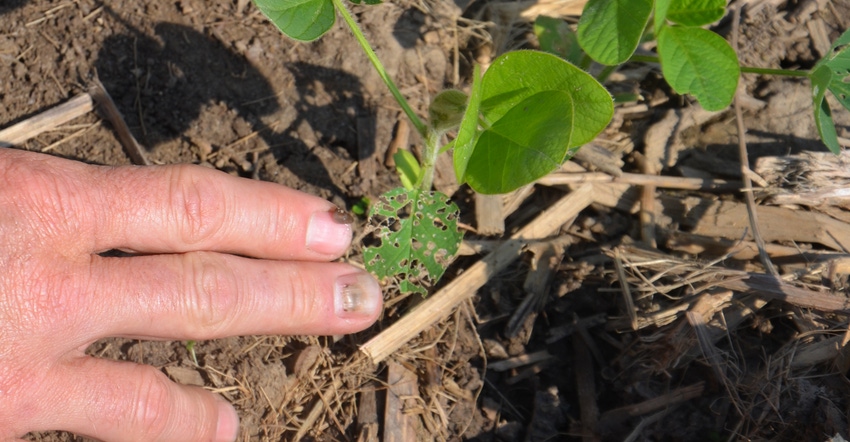
Steve Gauck wasn’t surprised to find slug feeding as soon as he stepped into the Soybean Watch ’19 field on July 8. Traditionally, that’s very late to find slugs and slug feeding. But Gauck learned two years ago that given the right conditions, slugs can hang around longer than most people believed; the 2017 season changed everyone’s minds.
Gauck even found a slug still at work on young bean leaves on July 8. Planted June 12, the soybeans were still at the V2 to V3 leaf stage. He also saw signs of feeding. “They can chew holes in small leaves,” says Gauck, a Beck’s sales agronomist based near Greensburg, Ind. Beck’s sponsors Soybean Watch ’19.
“You may see holes in a leaf and automatically think bean leaf beetle feeding,” he explains. “There was some of that in the field, especially in the variety treated with only Ilevo, not a full seed treatment with an insecticide.
“But in this case [see photo], it was evidence of slugs at work. They weren’t numerous enough or causing enough damage to threaten the crop at this point, but it was worth noting that they were still there. They will likely hang around as long as moist, damp conditions exist under the residue. If it turns dry, we probably won’t see them anymore.”
After his experiences in 2017, Gauck wasn’t surprised to find slugs this year. The 2017 season was also cool and wet early, although planting delays were not nearly as severe as in 2019. Until two years ago, conventional wisdom was that slugs would discontinue feeding and leave fields alone in late May to very early June.
What slugs can do
In 2017, slugs caused havoc in many fields, particularly in southeast Indiana but also in other areas. Several fields were replanted due to slugs that year.
“I remember finding them in the Soybean Watch field, too,” Gauck recalls. “It was late June. Slugs had thinned the stand to about 80,000 plants per acre in some locations.” The field still made 50 bushels per acre.
Gauck has responded to several reports of slugs in his area again this year, after a quiet 2018 season. In most areas, May was on the dry side and hot in 2018 — good for growing corn and planting soybeans, but not favorable to slugs.
“There was a little bit of replanting due to slugs this year, but it wasn’t like 2017,” Gauck observes. “And even though we found feeding in the Soybean Watch ’19 field in central Indiana on July 8, it didn’t appear that slugs thinned the stand.”
In fact, the field featured a respectable stand, averaging 107,000 plants per acre for the variety that didn’t have a full seed treatment, and 124,000 plants for the variety that was fully treated. “As long as we have 80,000 plants per acre, we should reach full yield potential, so we should be in good shape on this field this year,” Gauck says.
The problem with slugs is that there is no antidote once you find them, Gauck notes. That’s why when damage is severe enough to thin populations drastically, the only recourse is replanting the field and hoping for a better stand and warmer, drier weather that puts an end to slug activity.
About the Author(s)
You May Also Like




